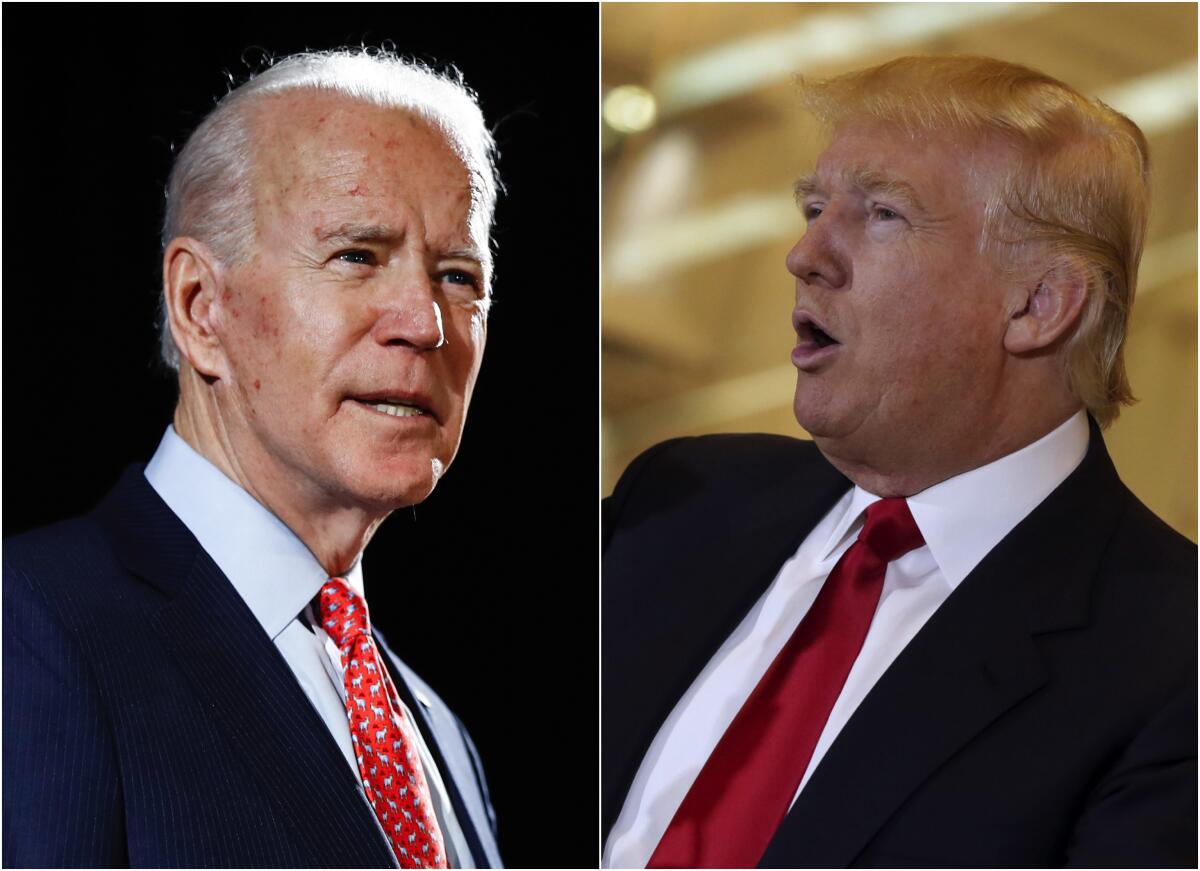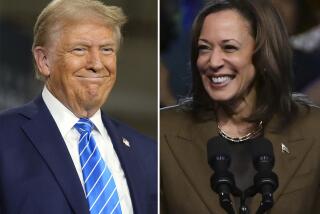Six months from the election, six states are poised to decide Trump-Biden race

- Share via
In six months, voters go to the polls — unless they’ve mailed in their ballot — to pick a president. It’s a national exercise that, practically speaking, consists of separate contests in 50 states and the District of Columbia.
As 2016 reminded many Americans, the White House is awarded not to the candidate who wins the popular vote but the one who garners the most support in the electoral college. There are 538 electoral votes awarded on the basis of those individual contests; it takes 270 to win the presidency.
Not every state is competitive. Some will vote for President Trump and others for former Vice President Joe Biden, no matter what happens between now and Nov. 3
That gives each candidate more than 200 electoral votes they can almost certainly count on. The balance are distributed across a dozen or so remaining states. Unless the race breaks strongly one way or the other, six of them will probably decide who sits in the White House starting Jan. 20, 2021.
Here’s a look at those key contests, with experienced political operatives in each state — one Democrat, one Republican — offering their thoughts on what it will take to win there in November:
ARIZONA (11 electoral votes)
2016 result: Donald Trump 48.7%, Hillary Clinton 45.1%
Since 1948, Bill Clinton is the only Democratic presidential hopeful to carry Arizona. Seeking reelection in 1996, he eked out his win with just 47% support. But Arizona has been thoroughly transformed since then.
The changes that helped turn Colorado, New Mexico and Nevada from Republican redoubts to blue-tilting bastions — a growing and energized Latino voting population, an influx of newcomers from more liberal environs such as California — have also been taking place in Arizona. In addition, Trump faces the risk of serious defections among female voters in the electorally crucial Phoenix suburbs.
The question is whether Biden can overcome Arizona’s long-standing skepticism toward Washington and its ilk, which runs particularly strong among rural voters.
Democrat Stacy Pearson: “For Joe Biden to win Arizona he needs to follow a centrist playbook. He has to understand that an Arizona independent is likely a recovering Republican libertarian who does not appreciate the Donald Trump effect.”
Republican Chuck Coughlin: “President Trump needs to convince the Arizona electorate that a Biden presidency will be [House Speaker] Nancy Pelosi and [Democratic Senate Leader] Chuck Schumer’s dream ... [that] they will change tax policy and change the culture of America in a very European progressive way and they’re far too risky to our country’s future.”
FLORIDA (29 electoral votes)
Trump 49%, Clinton 47.8%
No state balances on a knife’s edge like Florida, the most populous and consistently competitive of the nation’s battleground states. One reason may be the way Florida reflects the country at large. Parts of it are small-town rural, parts of it cosmopolitan. It’s a little bit Southern and a little bit Caribbean.
Since 1964, the state has gone with the winner in every presidential campaign save for 1992, when it backed incumbent George H.W. Bush over Bill Clinton. Demographic trends that could help Democrats in November, such as the growing black and Latino populations, are offset by trends that help Republicans, such as the influx of older, conservative white retirees.
Florida would seem a must-win for Trump, who has changed his official residence from Manhattan to the Mar-a-Lago resort in Palm Beach. The GOP, which holds the governorship and, after 2018, both U.S. Senate seats, has spent nonstop years on the ground honing its turnout operation, which may give the president a boost.
Democrat Steve Schale: “To win, Joe Biden needs to continue to do well in communities of color, run up large margins in the urban areas, and do well with retired voters who live along the I-4 corridor” between St. Petersburg and Daytona Beach.
Republican Brett Doster: “There’s no one key thing, but if you could boil it down to just a few absolutely necessaries, President Trump needs to get his share of the Puerto Rican vote and has got to have a dominant, dominant turnout in southwest Florida and the Panhandle.”
MICHIGAN (16 electoral votes)
Trump 47.5%, Clinton 47.3%
Trump took the White House by shattering the so-called blue wall, a cluster of industrial states — including Michigan — that had seemed reliably Democratic. He won the state, which last voted Republican in 1988, by less than 11,000 votes out of more than 4.5 million cast.
Both sides see the Wolverine State as the likeliest of the top battlegrounds to flip in November. The state’s popular Democratic governor, Gretchen Whitmer, is being mentioned as a possible Biden running mate, which could further enhance his prospects. One key will be the shape of the auto business, Michigan’s leading industry, come the fall. President Obama got a boost in his 2012 reelection bid from the lifeline Washington extended to Detroit during the Great Recession. As Obama’s vice president, Biden hopes for some residual goodwill.
There’s an added wrinkle: the possible candidacy of Rep. Justin Amash of Grand Rapids, a Republican-turned-independent, who could attract support in and around his congressional district, though it’s unclear which major party candidate that might hurt or help.
Democrat Jill Alper: “Joe Biden needs to successfully prosecute the argument that he’ll eliminate the chaos and unify the country, building upon his Michigan-specific credentials of helping to lead the auto rescue and successfully guide Detroit through bankruptcy.”
Republican Rusty Hills: “President Trump has got to hold on to white working-class voters and then possibly dig a little bit deeper and amplify that vote 3, 4, 5%. Also, he needs to limit the loss among suburban women.”
NORTH CAROLINA (15 electoral votes)
Trump 49.8%, Clinton 46.2%
When Obama carried North Carolina in 2008 — 49.7% to 49.4% over John McCain — he became the first Democrat to win the Tar Heel state since Jimmy Carter in 1976. In the next two elections, the state reverted to Republican form, but not by much.
North Carolina has been one of the fastest growing states in the country. Few better embody the chasm between the cities and suburbs, which are filled in North Carolina with Democratic-leaning college graduates working in the financial and high-tech industries, and the sprawling rural and exurban areas, which remain strongly Republican.
Partisan passions run deep; the state has a history in recent decades of acrimonious, closely fought contests, not just for the White House but also for U.S. Senate and, in 2016, the governor’s office. A robust black turnout is crucial for Biden’s success. In 2016, the African American vote fell from 2008 and 2012 levels, when Obama was running, and that helped contribute to Hillary Clinton’s loss.
Democrat Gary Pearce: “Joe Biden needs to offer a sensible, reasonable alternative to Donald Trump.”
Republican Carter Wrenn: “President Trump needs to whip coronavirus and get out his vote.”
PENNSYLVANIA (20 electoral votes)
Trump 48.2%, Clinton 47.5%
Trump became the first Republican since George H.W. Bush in 1988 to carry the state, the second chunk of the supposed blue wall to cave in on Democrats.
Hillary Clinton managed to win Philadelphia’s socially moderate, increasingly Democratic suburbs by an even bigger margin than Obama. But Trump enjoyed strong support in Rust Belt communities, carrying counties such as Luzerne and Erie that once were Democratic strongholds. Republicans hope to make energy an issue in a state that is a major natural gas producer, saying Biden’s stance on environmental issues and alternative fuels would eliminate sorely needed jobs.
But the former vice president enjoys one advantage Clinton lacked: He was born in blue-collar Scranton and spent more than three decades representing neighboring Delaware in the Senate, so there is a familiarity that could help blunt Trump’s attacks. His strong support among seniors could also help in a state with one of the oldest populations in the country.
Democrat Joe Shafer: “Joe Biden needs to continue the trend toward Democrats in the suburbs, running up the score, while making moderate progress from Clinton’s numbers in counties that moved toward Trump, like Erie, Luzerne and Northampton.”
Republican Charlie Gerow: “The Trump campaign will need to laser-focus on registration and getting to the polls voters that lean his way but did not vote in 2016 for some reason.”
WISCONSIN (10 electoral votes)
Trump 47.2%, Clinton 46.5%
Wisconsin was the third portion of the blue wall to crumble, voting Republican for the first time since President Reagan’s 1984 landslide reelection. Trump won in good part due to strong support in Wisconsin’s abundant small towns and rural areas, and a falloff in Democratic balloting in the state’s most populous city, Milwaukee. He also benefited from a sizable defection of Obama voters, many of them blue-collar workers, who shunned Hillary Clinton.
Democrats were heartened by turnout in last month’s election, run amid the pandemic, when a liberal challenger nabbed a state Supreme Court seat held by a conservative justice. The contest was just the latest skirmish in more than a decade’s worth of ruthless, all-out, partisan warfare.
Both sides agree the results in November are likely to be very close, in keeping with several presidential contests going back to 2000. Clinton all but ignored the state four years ago — she never set foot in Wisconsin after losing the April primary to Bernie Sanders — until it was too late. Biden is not likely to make that same mistake.
Democrat Mike Tate: “Joe Biden, in addition to having a robust turnout in urban areas, in particular Milwaukee, has got to compete and win votes in [suburban] Waukesha County and get the votes of blue-collar, high school-educated voters in Green Bay and the Fox Valley.”
Republican Brian Reisinger: “President Trump needs to tell a story of how he shook up the system and got results. This needs to be a campaign about his record getting the economy on a strong track, rebuilding our military and restoring some of the greatness people remember in Wisconsin and other parts of the country when they were kids and proud of our country.”
More to Read
Get the L.A. Times Politics newsletter
Deeply reported insights into legislation, politics and policy from Sacramento, Washington and beyond. In your inbox three times per week.
You may occasionally receive promotional content from the Los Angeles Times.









